英语四级段落匹配
- 格式:docx
- 大小:16.71 KB
- 文档页数:3
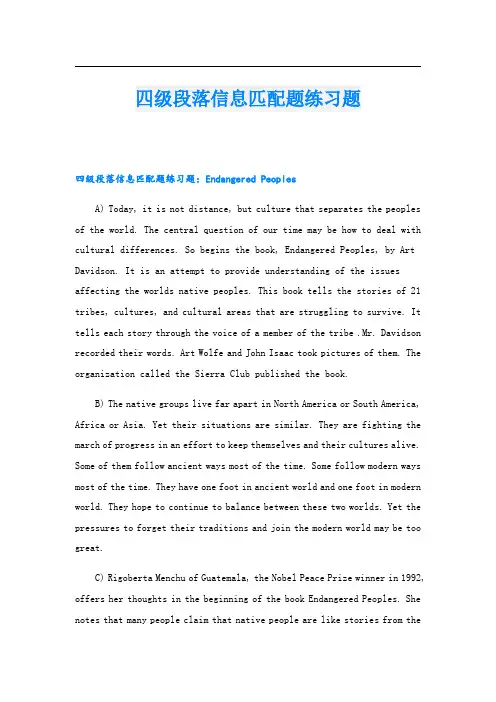
四级段落信息匹配题练习题四级段落信息匹配题练习题:Endangered PeoplesA) Today, it is not distance, but culture that separates the peoples of the world. The central question of our time may be how to deal with cultural differences. So begins the book, Endangered Peoples, by Art Davidson. It is an attempt to provide understanding of the issues affecting the worlds native peoples. This book tells the stories of 21 tribes, cultures, and cultural areas that are struggling to survive. It tells each story through the voice of a member of the tribe .Mr. Davidson recorded their words. Art Wolfe and John Isaac took pictures of them. The organization called the Sierra Club published the book.B) The native groups live far apart in North America or South America, Africa or Asia. Yet their situations are similar. They are fighting the march of progress in an effort to keep themselves and their cultures alive. Some of them follow ancient ways most of the time. Some follow modern ways most of the time. They have one foot in ancient world and one foot in modern world. They hope to continue to balance between these two worlds. Yet the pressures to forget their traditions and join the modern world may be too great.C) Rigoberta Menchu of Guatemala, the Nobel Peace Prize winner in 1992, offers her thoughts in the beginning of the book Endangered Peoples. She notes that many people claim that native people are like stories from thepast. They are ruins that have died. She disagrees strongly. She says native communities are not remains of the past. They have a future, and they have much wisdom and richness to offer the rest of the world.D) Art Davidson traveled thousands of miles around the world while working on the book. He talked to many people to gather their thoughts and feelings. Mr. Davidson notes that their desires are the same. People want to remain themselves~ he says. They want to raise their children the way they were raised. They want their children to speak their mother tongue, their own language. They want them to have their parents values and customs. Mr. Davidson says the peoples cries are the same: "Does our culture have to die? Do we have to disappear as a people?"E) Art Davidson lived for more than 25 years among native people in the American state of Alaska. He says his interest in native peoples began his boyhood when he found an ancient stone arrowhead. The arrowhead was used as a weapon to hunt food. The hunter was an American Indian, long dead. Mr. Davidson realized then that Indians had lived in the state of Colorado, right where he was standing. And it was then, he says, that he first wondered: "Where are they? Where did they go? "He found answers to his early question. Many of the native peoples had disappeared. They were forced off their lands. Or they were killed in battle. Or they died from diseases brought by new settlers. Other native peoples remained, but they had to fight to survive the pressures of the modern world.F) The Gwichin are an example of the survivors. They have lived in what is now Alaska and Canada for 10,000 years. Now about 5,000 Gwichin remain. They are mainly hunters. They hunt the caribou, a large deer with big horns that travels across the huge spaces of the far north. Forcenturies, they have used all parts of the caribou: the meat for food, the skins for clothes, the bones for tools. Hunting caribou is the way of life of the Gwichin.G) One Gwichin told Art Davidson of memories from his childhood. It was a time when the tribe lived quietly in its own corner of the world. He spoke to Mr. Davidson in these words: "As long as I can remember, someone would sit by a fire on the hilltop every spring and autumn. His job was to look for caribou. If he saw a caribou, he would wave his arms or he would make his fire to give off more smoke. Then the village would come to life! People ran up to the hilltop. The tribes seemed to be at its best at these gatherings. We were all filled with happiness and sharing!"H) About ten years ago, the modern world invaded the quiet world of the Gwich in. Oil companies wanted to drill for oil in the Arctic National Wildlife Preserve. This area was the please where the caribou gave birth to their young. The Gwichin feared the caribou would disappear. One Gwich in woman describes the situation in these words: "Oil development threatens the caribou. If the caribou are threatened, then the people are threatened. Oil company official and American lawmakers do not seem to understand. They do not come into our homes and share our food. They have never tried to understand the feeling expressed in our songs and our prayers. They have not seen the old people cry. Our elders have seen parts of our culture destroyed. They worry that our people may disappear forever."I) A scientist with a British oil company dismisses (驳回,打消) the fears of the Gwichin. He also says they have no choice. They will have to change. The Gwich in, however, are resisting. They took legal actionto stop the oil companies. But they won only a temporary ban on oil development in the Arctic National Wildlife Preserve. Pressures continue on other native people, as Art Davidson describes in his book. The pressures come from expanding populations, dam projects that flood tribal lands, and political and economic conflicts threaten the culture, lands, and lives of such groups as the Quechua of Peru, the Malagasy of Madagascar and the Ainu of Japan.J) The organization called Cultural Survival has been in existence for 22 years. It tries to protect the rights and cultures of peoples throughout the world. It has about 12,000 members. And it receives help from a large number of students who work without pay. Theodore MacDonald is director of the Cultural Survival Research Center. He says the organization has three main jobs. It does research and publishes information. It works with native people directly. And it creates markets for goods produced by native communities.K) Late last year, Cultural Survival published a book called State of the Peoples: a Global Human Rights Report on Societies in Danger. The book contains reports from researchers who work for Cultural Survival, from experts on native peoples, and from native peoples themselves. The book describes the conditions of different native and minority groups. It includes longer reports about several threatened societies, including the Penan of Malaysia and the Anishina be of North American. And it provides the names of organizations similar to Cultural Survival for activists, researchers and the press.L) David May bury-Lewis started the Cultural Survival organization. Mr. May bury-Lewis believes powerful groups rob native peoples of theirlives, lands, or resources. About 6,000 groups are left in the world. A native group is one that has its own langue. It has a long-term link to a homeland. And it has governed itself. Theodore MacDonald says Cultural Survival works to protect the rights of groups, not just individual people. He says the organization would like to develop a system of early warnings when these rights are threatened .Mr. MacDonald notes that conflicts between different groups within a country have been going on forever and will continue. Such conflicts, he says, cannot be prevented. But they do not have to become violent. What Cultural Survival wants is to help set up methods that lead to peaceful negotiations of traditional differences. These methods, he says, are a lot less costly than war.46. Rigoberta Menchu, the Nobel Peace Prize winner in 1992, writes preface for the book Endangered Peoples.47. The book Endangered Peoples contents not only words, but also pictures.48. Art Davidsons initial interest in native people was aroused by an ancient stone arrowhead he found in his childhood, which was once used by an American Indian hunter.49. The native groups are trying very hard to balance between the ancient world and the modern world.50. By talking with them, Art Davidson finds that the native people throughout the world desire to remain themselves.51. Most of the Gwichin are hunters, who live on hunting caribou.52. Cultural Survival is an organization which aims at protecting the rights and cultures of peoples throughout the world.53. According to Theodore MacDonald, the Cultural Survival organization .would like to develop a system of early warnings when a societys rights are to be violated.54. The book State of the Peoples: a Global Human Rights Report on Societies in Danger describes the conditions of different native and minority groups.55. The Gwich in tried to stop oil companies from drilling for oil in the Arctic National Wildlife Preserve for fear that it should drive the caribou away。

大学英语四级段落信息匹配题解题技巧一.题型介绍2013年12月大学英语四级改革后,题型有局部变化。
原快速阅读理解调整为长篇阅读理解,篇章长度和难度不变。
篇章后附有10个句子,每句一题。
每句所含的信息出自篇章的某一段落,要求考生找出与每句所含信息相匹配的段落。
有的段落可能对应两题,有的段落可能不对应任何一题。
四级考试需要各位同学做的是,大家需要去看十个左右的段落,然后去匹配十个信息点。
但是到六级当中,我们的难度就要增加了,我们见到的情况是六级当中变成了15个段落,去匹配十个信息点。
阅读题里出现的段落信息匹配题占10%的分值。
整个阅读部分占总分值的35%,考试时间只有forty minutes,建议大家在段落信息匹配题当中花去的时间千万不要超过15分钟,所以整体上看做阅读时需要注意一个很重要的问题:严控时间。
但总体来看,不管题型怎么变,其实学习方法没变,还是仍旧需要大家提高阅读的能力,比如说读文章的时候,是不是直接拿英语读,如果读快速阅读的时候,还是拿中文边翻译边读的话,会发现阅读速度一直会比较慢,所以那么长的文章很难找到细节,所以大家一定要养成拿英语直接阅读的这样一种习惯,这样才能保证我们的阅读真正速度又快又准。
每一年考四六级的考生中,都会有很多考生因为时间不够、题做不完而折戟沉沙,而几乎全国考生都会在一个阅读这个模块超时大量的时间,而且由于我们的精度得分确实太大,因为20%的精读只有10道题,一道题占2%乘以710分,一道精读题目的分数就达到了14.2分将近15分。
分值太大导致各位同同学容易在这个地方花去大量时间,但是你要明白这个部分的时间花的再久也只有20%,你完全没有理由因为20%去损失另外一个10%,而且你还不能确定你这20%是否可以得到一个非常好的成绩,所以提醒大家:掌控时间非常重要,每一个环节限时来做,而现在做题的时候就必须要控制时间。
从样卷看,此次涉及改革题目的特点是:1、做题时间10~15分钟(整体阅读包括选词填空、匹配和精度,共计40分钟);2、四级样卷显示需要将10道题目信息配对到9个段落中;3、六级样卷显示需要将10道题目信息配对到15个段落中;4、考试说明提到,某段可能被用到两次,而某段可能完全不被涉及。
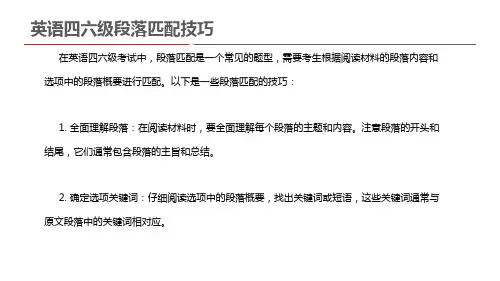
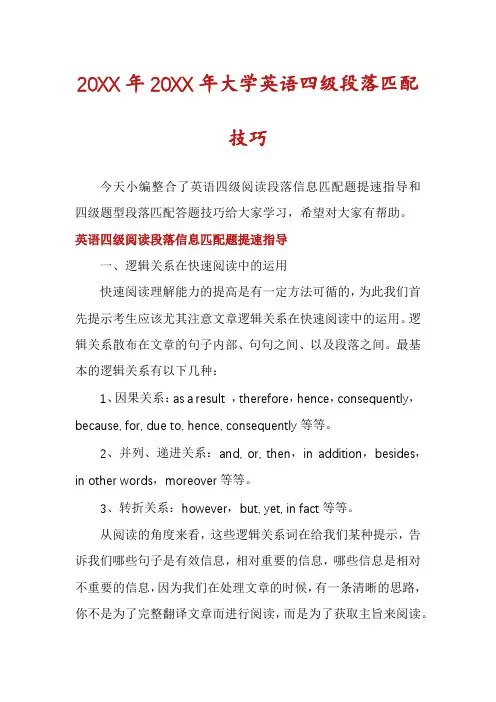
20XX年20XX年大学英语四级段落匹配技巧今天小编整合了英语四级阅读段落信息匹配题提速指导和四级题型段落匹配答题技巧给大家学习,希望对大家有帮助。
英语四级阅读段落信息匹配题提速指导一、逻辑关系在快速阅读中的运用快速阅读理解能力的提高是有一定方法可循的,为此我们首先提示考生应该尤其注意文章逻辑关系在快速阅读中的运用。
逻辑关系散布在文章的句子内部、句句之间、以及段落之间。
最基本的逻辑关系有以下几种:1、因果关系:as a result ,therefore,hence,consequently,because, for, due to, hence, consequently等等。
2、并列、递进关系:and, or, then,in addition,besides,in other words,moreover等等。
3、转折关系:however,but, yet, in fact等等。
从阅读的角度来看,这些逻辑关系词在给我们某种提示,告诉我们哪些句子是有效信息,相对重要的信息,哪些信息是相对不重要的信息,因为我们在处理文章的时候,有一条清晰的思路,你不是为了完整翻译文章而进行阅读,而是为了获取主旨来阅读。
二、标点符号在快速阅读中的运用可以运用标点符号(破折号、小括号、冒号)了解不认识的词汇或句子的含义。
因为这些标点符号的出现就是为了更进一步地其前的信息。
但同时,由于快速阅读用词相对比较简单,很容易理解和把握标点前的被解释信息,所以,可以将这些标点符号后面的信息删除,从而更加快速地把握文章的主旨。
三、特殊信息点在快速阅读中的运用所谓“特殊信息点”是指那些很容易在文章中识别的词汇,诸如时间、数字、大写字母等形式的语言点。
这些形式的表达一方面很容易识别出来,另一方面,这些信息点的表现的一般都是文章的琐碎信息,对于主旨的理解和把握而言,不过是更进一步论证而已。
因此,可以忽略这些信息的阅读。
如果后面测试的题点中确实涉及到了,再回来细读也无妨,毕竟它们的表现形式非常利于查找和定位判断。
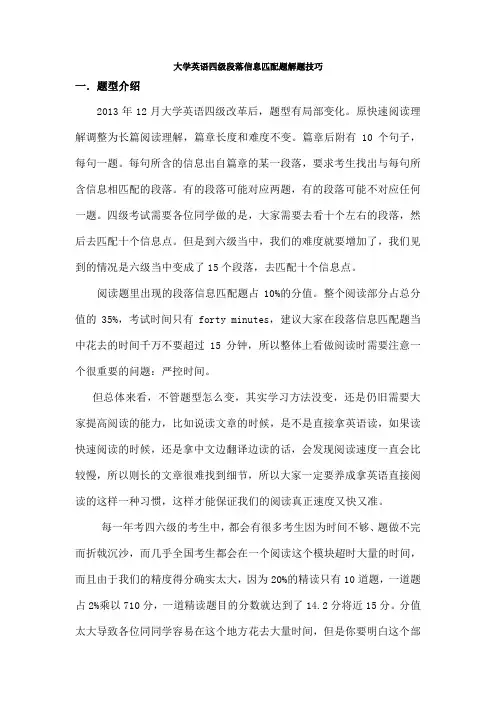
大学英语四级段落信息匹配题解题技巧一.题型介绍2013年12月大学英语四级改革后,题型有局部变化。
原快速阅读理解调整为长篇阅读理解,篇章长度和难度不变。
篇章后附有10个句子,每句一题。
每句所含的信息出自篇章的某一段落,要求考生找出与每句所含信息相匹配的段落。
有的段落可能对应两题,有的段落可能不对应任何一题。
四级考试需要各位同学做的是,大家需要去看十个左右的段落,然后去匹配十个信息点。
但是到六级当中,我们的难度就要增加了,我们见到的情况是六级当中变成了15个段落,去匹配十个信息点。
阅读题里出现的段落信息匹配题占10%的分值。
整个阅读部分占总分值的35%,考试时间只有forty minutes,建议大家在段落信息匹配题当中花去的时间千万不要超过15分钟,所以整体上看做阅读时需要注意一个很重要的问题:严控时间。
但总体来看,不管题型怎么变,其实学习方法没变,还是仍旧需要大家提高阅读的能力,比如说读文章的时候,是不是直接拿英语读,如果读快速阅读的时候,还是拿中文边翻译边读的话,会发现阅读速度一直会比较慢,所以则长的文章很难找到细节,所以大家一定要养成拿英语直接阅读的这样一种习惯,这样才能保证我们的阅读真正速度又快又准。
每一年考四六级的考生中,都会有很多考生因为时间不够、题做不完而折戟沉沙,而几乎全国考生都会在一个阅读这个模块超时大量的时间,而且由于我们的精度得分确实太大,因为20%的精读只有10道题,一道题占2%乘以710分,一道精读题目的分数就达到了14.2分将近15分。
分值太大导致各位同同学容易在这个地方花去大量时间,但是你要明白这个部分的时间花的再久也只有20%,你完全没有理由因为20%去损失另外一个10%,而且你还不能确定你这20%是否可以得到一个非常好的成绩,所以提醒大家:掌控时间非常重要,每一个环节限时来做,而现在做题的时候就必须要控制时间。
从样卷看,此次涉与改革题目的特点是:1、做题时间10~15分钟(整体阅读包括选词填空、匹配和精度,共计40分钟);2、四级样卷显示需要将10道题目信息配对到9个段落中;3、六级样卷显示需要将10道题目信息配对到15个段落中;4、考试说明提到,某段可能被用到两次,而某段可能完全不被涉与。
![[实用参考]大学英语四级段落信息匹配题技巧](https://uimg.taocdn.com/8649f344561252d380eb6ecb.webp)
英语四、六级段落信息匹配题一、英语四级段落信息匹配题是什么?长篇阅读理解篇章后附有10个句子,每句一题。
每句所含的信息出自篇章的某一段落,要求考生找出与每句所含信息相匹配的段落。
有的段落可能对应两题,有的段落可能不对应任何一题。
四级考试需要各位同学做的是,大家需要去看十个左右的段落,然后去匹配十个信息点。
但是到六级当中,我们的难度就要增加了,我们见到的情况是六级当中变成了15个段落,去匹配十个信息点。
但总体来看,不管题型怎么变,其实学习方法没变,还是仍旧需要大家提高阅读的能力,比如说读文章的时候,是不是直接拿英语读,如果读快速阅读的时候,还是拿中文边翻译边读的话,会发现阅读速度一直会比较慢,所以那么长的文章很难找到细节,所以大家一定要养成拿英语直接阅读的这样一种习惯,这样才能保证我们的阅读速度又快又准。
二、信息匹配题难点分析1.考生难以按照阅读题一贯遵循的“顺序原则”解题。
由于这一题型要求考生把细节信息与其所在的段落进行匹配,因此细节信息的排列绝对是“乱序的”,这就意味着考生从文章开头到结尾按顺序定位的方法是行不通的。
2.题干信息复杂,考生难以迅速抓住要领。
题干中的细节信息通常是极复杂和繁琐的名词短语或长难句,考生往往在寻找到合适的定位词之前,就已经被题干信息的复杂表述弄得晕头转向了。
3.考生难以寻找到合适的定位词。
即使考生能够读懂题干中晦涩难懂的细节信息,但也会在寻找定位词时遇到很大障碍。
因为题干提供的细节信息中往往不会出现非常明显的定位词(如数字、时间、地点、人物、特殊字体和特殊符号等)。
即使考生能够找到一个定位词,这一定位词也通常和文章主题密切相关,会在文章中多次出现,因而也没有太大的意义。
三、匹配题出题特点及应试技巧匹配类题型有很多种,常见的种类有:1)人名-观点匹配;2).地名-描述匹配;3)句子-句子匹配;4)分类题(Classification);5)段落-标题匹配;6段落-细节匹配。
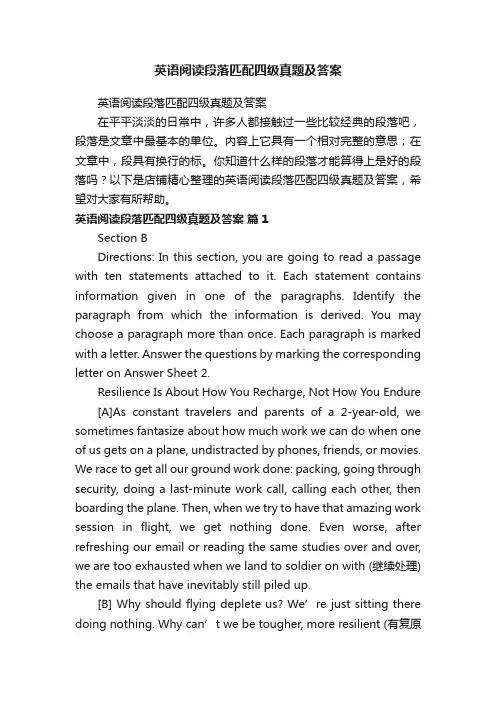
英语阅读段落匹配四级真题及答案英语阅读段落匹配四级真题及答案在平平淡淡的日常中,许多人都接触过一些比较经典的段落吧,段落是文章中最基本的单位。
内容上它具有一个相对完整的意思;在文章中,段具有换行的标。
你知道什么样的段落才能算得上是好的段落吗?以下是店铺精心整理的英语阅读段落匹配四级真题及答案,希望对大家有所帮助。
英语阅读段落匹配四级真题及答案篇1Section BDirections: In this section, you are going to read a passage with ten statements attached to it. Each statement contains information given in one of the paragraphs. Identify the paragraph from which the information is derived. You may choose a paragraph more than once. Each paragraph is marked with a letter. Answer the questions by marking the corresponding letter on Answer Sheet 2.Resilience Is About How You Recharge, Not How You Endure[A]As constant travelers and parents of a 2-year-old, we sometimes fantasize about how much work we can do when one of us gets on a plane, undistracted by phones, friends, or movies. We race to get all our ground work done: packing, going through security, doing a last-minute work call, calling each other, then boarding the plane. Then, when we try to have that amazing work session in flight, we get nothing done. Even worse, after refreshing our email or reading the same studies over and over, we are too exhausted when we land to soldier on with (继续处理) the emails that have inevitably still piled up.[B] Why should flying deplete us? We’re just sitting there doing nothing. Why can’t we be tougher, more resilient (有复原力的) and determined in our work so we can accomplish all of the goals we set for ourselves? Based on our current research, we have come to realize that the problem is not our hectic schedule or the plane travel itself; the problem comes from a misconception of what it means to be resilient, and the resulting impact of overworking.[C] We often take a milita ristic, “tough” approach to resilience and determination like a Marine pulling himself through the mud, a boxer going one more round, or a football player picking himself up off the ground for one more play. We believe that the longer we tough it out, the tougher we are, and therefore the more successful we will be. However, this entire conception is scientifically inaccurate.[D]The very lack of a recovery period is dramatically holding back our collective ability to be resilient and successful. Research has found that there is a direct correlation between lack of recovery and increased incidence of health and safety problems. And lack of recovery—whether by disrupting sleep with thoughts of work or having continuous cognitive arousal by watching our phones—is costing our companies $62 billion a year in lost productivity.[E] And just because work stops, it doesn’t mean we are recovering. We “stop” work sometimes at 5pm, but then we spend the night wrestling with solutions to work problems, talking about our work over dinner, and falling asleep thinking about how much work we’ll do tomorrow. In a study just released, researchers from Norway found that 7.8% of Norwegians have become workaholics(工作狂). The scientists cite a definition of “workaholism” as “being overly concerned about work, driven by an uncontrollable work motivation, andinvesting so much time and effort in work that it impairs other important life areas.”[F] We believe that the number of people who fit that definition includes the majority of American workers, which prompted us to begin a study of workaholism in the U.S. Our study will use a large corporate dataset from a major medical company to examine how technology extends our working hours and thus interferes with necessary cognitive recovery, resulting in huge health care costs and turnover costs for employers.[G] The misconception of resilience is often bred from an early age. Parents trying to teach their children resilience might celebrate a high school student staying up until 3am to finish a science fair project. What a distortion of resilience! A resilient child is a well-rested one. When an exhausted student goes to school, he risks hurting everyone on the road with his impaired driving; he doesn’t have the cognitive resources to do well on his English test; he has lower self-control with his friends; and at home, he is moody with his parents. Overwork and exhaustion are the opposite of resilience and the bad habits we acquire when we’re young only magnify when we hit the workforce.[H] As Jim Loehr and Tony Schwartz have written, if you have too much time in the performance zone, you need more time in the recovery zone, otherwise you risk burnout. Gathering your resources to “try hard” requires burning energy in order to overcome your currently low arousal level. It also worsens exhaustion. Thus the more imbalanced we become due to overworking, the more value there is in activities that allow us to return to a state of balance. The value of a recovery period rises in proportion to the amount of work required of us.[I] So how do we recover and build resilience? Most peopleassume that if you stop doing a task like answering emails or writing a paper, your brain will naturally recover, so that when you start again later in the day or the next morning, you’ll have your energy back. But surely everyone reading this has had times when you lie in bed for hours, unable to fall asleep because your brain is thinking about work. If you lie in bed for eight hours, you may have rested, but you can still feel exhausted the next day. That’s because rest and recovery are not the same thing.[J] If you’re trying to build resilience at work, you need adequate internal and external recovery periods. As researchers Zijlstra, Cropley and Rydstedt write in t heir 2014 paper: “Internal recovery refers to the shorter periods of relaxation that take place within the frames of the work day or the work setting in the form of short scheduled or unscheduled breaks, by shifting attention or changing to other work tasks when the mental or physical resources required for the initial task are temporarily depleted or exhausted. External recovery refers to actions that take place outside of work—e.g. in the free time between the work days, and during weekends, holidays or v acations.” If after work you lie around on your bed and get irritated by political commentary on your phone or get stressed thinking about decisions about how to renovate your home, your brain has not received a break from high mental arousal states. Our brains need a rest as much as our bodies do.[K] If you really want to build resilience, you can start by strategically stopping. Give yourself the resources to be tough by creating internal and external recovery periods. Amy Blankson describes how to strategically stop during the day by using technology to control overworking. She suggests downloading the Instant or Moment apps to see how many times you turn onyour phone each day. You can also use apps like Offtime or Unplugged to create tech free zones by strategically scheduling automatic airplane modes. The average person turns on their phone 150 times every day. If every distraction took only 1 minute, that would account for 2.5 hours a day.[L] In addition, you can take a cognitive break every 90 minutes to charge your batteries. Try to not have lunch at your desk, but instead spend time outside or with your friends—not talking about work. Take all of your paid time off, which not only gives you recovery periods, but raises your productivity and likelihood of promotion.[M] As for us, we’ve started using our plane time as a work-free zone, and thus time to dip into the recovery phase. The results have been fantastic. We are usually tired already by the time we get on a plane, and the crowded space and unstable internet connection make work more challenging. Now, instead of swimming upstream, we relax, sleep, watch movies, or listen to music. And when we get off the plane, instead of being depleted, we feel recovered and ready to return to the performance zone.36. It has been found that inadequate recovery often leads to poor health and accidents.37. Mental relaxation is much needed, just as physical relaxation is.38. Adequate rest not only helps one recover, but also increases one’s work efficiency.39. The author always has a hectic time before taking a flight.40. Recovery may not take place even if one seems to have stopped working.41. It is advised that technology be used to prevent people from overworking.42. Contrary to popular belief, rest does not equal recovery.43. The author has come to see that his problem results froma misunderstanding of the meaning of resilience.44. People’s distorted view about resilience may have developed from their upbringing.45. People tend to think the more determined they are, the greater their success will be.36. 答案:D。
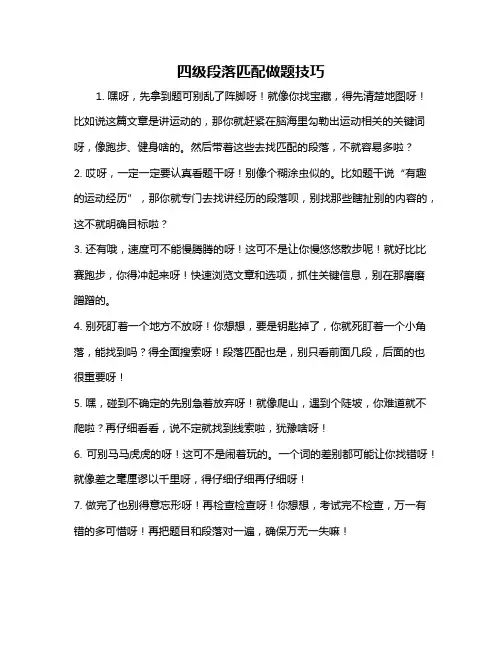
四级段落匹配做题技巧
1. 嘿呀,先拿到题可别乱了阵脚呀!就像你找宝藏,得先清楚地图呀!比如说这篇文章是讲运动的,那你就赶紧在脑海里勾勒出运动相关的关键词呀,像跑步、健身啥的。
然后带着这些去找匹配的段落,不就容易多啦?
2. 哎呀,一定一定要认真看题干呀!别像个糊涂虫似的。
比如题干说“有趣的运动经历”,那你就专门去找讲经历的段落呗,别找那些瞎扯别的内容的,这不就明确目标啦?
3. 还有哦,速度可不能慢腾腾的呀!这可不是让你慢悠悠散步呢!就好比比赛跑步,你得冲起来呀!快速浏览文章和选项,抓住关键信息,别在那磨磨蹭蹭的。
4. 别死盯着一个地方不放呀!你想想,要是钥匙掉了,你就死盯着一个小角落,能找到吗?得全面搜索呀!段落匹配也是,别只看前面几段,后面的也很重要呀!
5. 嘿,碰到不确定的先别急着放弃呀!就像爬山,遇到个陡坡,你难道就不爬啦?再仔细看看,说不定就找到线索啦,犹豫啥呀!
6. 可别马马虎虎的呀!这可不是闹着玩的。
一个词的差别都可能让你找错呀!就像差之毫厘谬以千里呀,得仔细仔细再仔细呀!
7. 做完了也别得意忘形呀!再检查检查呀!你想想,考试完不检查,万一有错的多可惜呀!再把题目和段落对一遍,确保万无一失嘛!
我的观点结论就是:只要掌握这些技巧,四级段落匹配就没那么难啦,大家加油呀!。
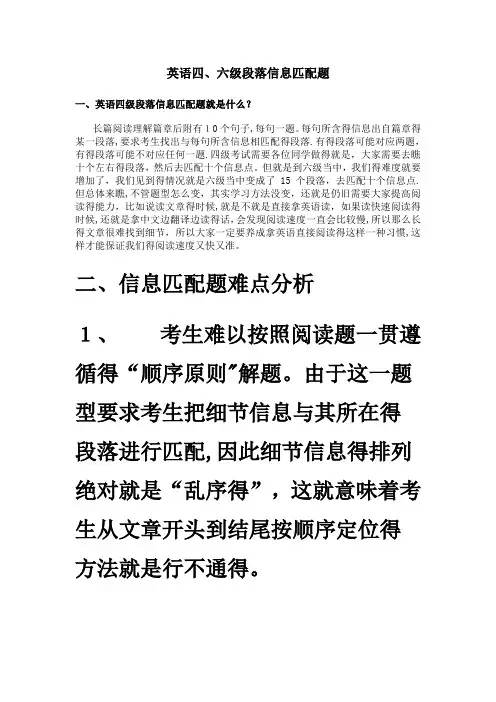
英语四、六级段落信息匹配题一、英语四级段落信息匹配题就是什么?长篇阅读理解篇章后附有10个句子,每句一题。
每句所含得信息出自篇章得某一段落,要求考生找出与每句所含信息相匹配得段落.有得段落可能对应两题,有得段落可能不对应任何一题.四级考试需要各位同学做得就是,大家需要去瞧十个左右得段落,然后去匹配十个信息点。
但就是到六级当中,我们得难度就要增加了,我们见到得情况就是六级当中变成了15个段落,去匹配十个信息点.但总体来瞧,不管题型怎么变,其实学习方法没变,还就是仍旧需要大家提高阅读得能力,比如说读文章得时候,就是不就是直接拿英语读,如果读快速阅读得时候,还就是拿中文边翻译边读得话,会发现阅读速度一直会比较慢,所以那么长得文章很难找到细节,所以大家一定要养成拿英语直接阅读得这样一种习惯,这样才能保证我们得阅读速度又快又准。
二、信息匹配题难点分析1、考生难以按照阅读题一贯遵循得“顺序原则"解题。
由于这一题型要求考生把细节信息与其所在得段落进行匹配,因此细节信息得排列绝对就是“乱序得”,这就意味着考生从文章开头到结尾按顺序定位得方法就是行不通得。
2、题干信息复杂,考生难以迅速抓住要领。
题干中得细节信息通常就是极复杂与繁琐得名词短语或长难句,考生往往在寻找到合适得定位词之前,就已经被题干信息得复杂表述弄得晕头转向了。
3、考生难以寻找到合适得定位词.即使考生能够读懂题干中晦涩难懂得细节信息,但也会在寻找定位词时遇到很大障碍.因为题干提供得细节信息中往往不会出现非常明显得定位词(如数字、时间、地点、人物、特殊字体与特殊符号等)。
即使考生能够找到一个定位词,这一定位词也通常与文章主题密切相关,会在文章中多次出现,因而也没有太大得意义。
三、匹配题出题特点及应试技巧匹配类题型有很多种,常见得种类有:1)人名-观点匹配;2)、地名—描述匹配;3)句子-句子匹配;4)分类题(Classification);5)段落—标题匹配;6段落-细节匹配。
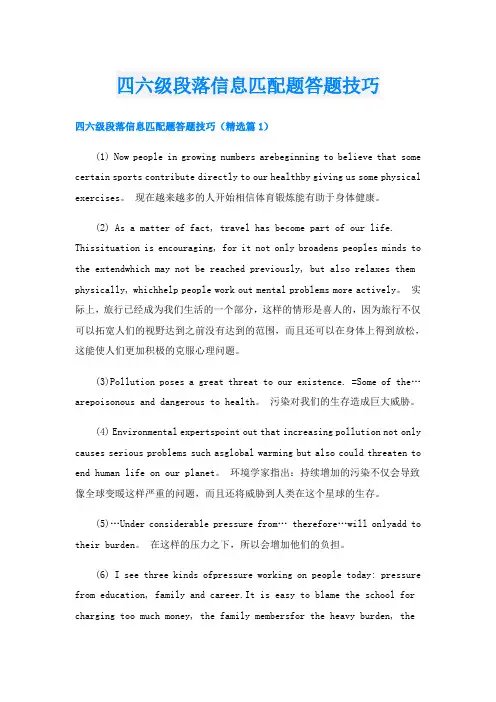
四六级段落信息匹配题答题技巧四六级段落信息匹配题答题技巧(精选篇1)(1) Now people in growing numbers arebeginning to believe that some certain sports contribute directly to our healthby giving us some physical exercises。
现在越来越多的人开始相信体育锻炼能有助于身体健康。
(2) As a matter of fact, travel has become part of our life. Thissituation is encouraging, for it not only broadens peoples minds to the extendwhich may not be reached previously, but also relaxes them physically, whichhelp people work out mental problems more actively。
实际上,旅行已经成为我们生活的一个部分,这样的情形是喜人的,因为旅行不仅可以拓宽人们的视野达到之前没有达到的范围,而且还可以在身体上得到放松,这能使人们更加积极的克服心理问题。
(3)Pollution poses a great threat to our existence. =Some of the…arepoisonous and dangerous to health。
污染对我们的生存造成巨大威胁。
(4) Environmental expertspoint out that increasing pollution not only causes serious problems such asglobal warming but also could threaten to end human life on our planet。

英语四级段落信息匹配题及答案如英语俨然也成为了一门必修必须掌握的学科,英语四级已经成为大学生们很基本的一门考试了,今天店铺在这里为大家分享一些英语四级段落信息匹配题,欢迎大家阅读!英语四级段落信息匹配题篇1Paper--More than Meets the EyeA) We are surrounded by so much paper and card that it is easy to forget just how complex it is. There are many varieties and grades of paper materials, and whilst it is fairly easy to spot the varieties, it is far more difficult to spot the grades.B) It needs to be understood that most paper and card is manufactured for a specific purpose, so that whilst the corn-flake packet may look smart, it is clearly not something destined for the archives. It is made to look good, but only needs a limited life span. It is also much cheaper to manufacture than high grade card.C) Paper can be made from an almost endless variety of cellulose-based material which will include many woods, cottons and grasses or which papyrus is an example and from where we get the word "paper". Many of these are very specialized, but the preponderance of paper making has been from soft wood and cotton or rags, with the bulk being wood-based.Paper from WoodD) In order to make wood into paper it needs to be broken down into fine strands. Firstly by powerfulmachinery and then boiled with strong alkalies such as caustic soda, until a fine pulp of cellulose fibers is produced. It is from this pulp that the final product is made, relying on the bonding together of the cellulose into layers. That, in a very small nutshell, is the essence of papermaking from wood. However, the reality is rather more complicated. In order to give us our white paper and card, the makers will addbleach and other materials such as china clay and additional chemicals.E) A further problem with wood is that it contains a material that is not cellulose. Something calledlignin. This is essential for the tree since it holds the cellulose fibres together, but if it is incorporated into the manufactured paper it presents archivists with a problem. Lignin eventually breaks down and releases acid products into the paper. This will weaken the bond between the cellulose fibers and the paper will become brittle and look rather brown and careworn. We have all seen this in old newspapers and cheap paperback books. It has been estimated that most paper back books will have a life of notgreater than fifty years. Not what we need for our archives.F) Since the lignin can be removed from the paper pulp during manufacture, the obvious question is "why is it left in the paper?" The answer lies in the fact that lignin makes up a considerable part of the tree. By leaving the lignin in the pulp a papermaker can increase his paper yield from a tree to some 95%. Removing it means a yield of only 35%. It is clearly uneconomic to remove the lignin for many paper and card applications.G) It also means, of course, that lignin-free paper is going to be more expensive, but that is nevertheless what the archivist must look for in his supplies. There is no point whatsoever in carefully placing our valuable artifacts in paper or card that is going to hasten their demise. Acid is particularly harmful to photographic materials, causing them to fade and is some cases simply vanish!H) So, how do we tell a piece of suitable paper or card fromone that is unsuitable? You cannot do it by simply looking, and rather disappointingly, you cannot always rely on the label. "Acid-free" might be true inasmuch as a test on the paper may indicate that it is a neutral material at this time. But lignin can take years before it starts the inevitable process of breaking down, and in the right conditions it will speed up enormously.I) Added to this, as I have indicated earlier, paper may also contain other materials added during manufacture such as bleach, china clay, chemical whiteners and size. This looks like a bleak picture, and it would be but for the fact that there are suppliers who will guarantee the material that they sell. If you want to be absolutely sure that you are storing in, or printing on, the correct material then this is probably the only way.J) Incidentally, acids can migrate from material to material. Lining old shoe boxes with good quality acid-free paper will do little to guard the contents. The acid will get there in the end.Paper from RagK) Paper is also commonly made from cotton and rag waste. This has the advantage of being lignin-free, but because there is much less cotton and rag than trees, it also tends to be much more expensive than wood pulp paper. You will still need to purchase from a reliable source though, since even rag paper and card can contain undesirable additives.L) A reliable source for quality rag papers is a recognized art stockiest. Many water color artists insist on using only fine quality rag paper and board.M) The main lesson to learn from this information is that you cannot rely on purchasing archival materials from the high street. The only safe solution is to purchase from specialist suppliers. It may cost rather more, but in the end you will know that yourimportant and valuable data and images have the best home possible.1. The corn-flake packet is cheaper than high grade card.2. There are a lot of materials which can be used for making paper, but the superiority ones are soft wood, cotton and rags.3. During the whole manufacturing process, the final product is made from a pulp of cellulose fibres.4. In order to make white paper and card, the makers will add bleach.5. Liguin is essential for the tree but it will make paper easy to break.6. Many paper producers will preserve lignin during manufacture, because leaving the lignin will make more paper from a tree.7. Acid is particularly harmful to photographic materials.8. If the lignin is removed from the paper, the paper will be more expensive.9. Although free of lignin, paper made from cotton and rag waste can also cost more money than wood pulp paper because there is much less cotton and rag than trees.10. What we can learn from "Paper from Rag" is that you had better buy archival materials from specialist suppliers.答案参考:1. B 根据题干中的信息提示词corn—flake packet,high grade card,可定位到文章第二段,该部分最后提到corn-flake packet在制造过程中比高等级的纸(high grade card)便宜.2. C 根据题干中的信息提示词soft wood,cotton and rags,可定位到文章第三段最后一句。
四级段落匹配题规则
四级段落匹配题是英语四级阅读理解中的一种常见题型。
这种题目要求考生根
据题目中的问题,从给定的段落中选择适合的答案。
在解答这种题目时,考生需要注意以下几点规则。
首先,要仔细阅读题目和给定的段落。
题目中会给出一个或多个问题,考生需
要理解这些问题的要点。
然后,考生需要仔细阅读给定的段落,理解其中的内容和信息。
其次,要扫描段落中的关键词。
在给定的段落中,关键词通常会与题目中的问
题相关。
扫描这些关键词有助于考生快速找到与问题匹配的答案。
第三,要注意段落的结构和逻辑关系。
段落通常由主题句、支持句和总结句组成。
考生可以通过理解段落的结构和逻辑关系,来定位与问题相关的信息。
第四,要注意段落的上下文。
有时,题目中的问题可能需要考生在给定的段落
之前或之后寻找答案。
因此,考生需要仔细阅读上下文,找到相关的信息。
最后,要选择最佳答案。
在选择答案时,要根据题目的要求和给定的段落中找
到的信息进行匹配。
如果段落中有多个答案看似正确,考生需要选择最相关或最准确的答案。
综上所述,四级段落匹配题是一种需要仔细阅读和分析的题型。
考生需要通过
理解题目要求、扫描关键词、分析段落结构和逻辑关系,来确定与问题匹配的答案。
熟悉并遵循这些规则可以帮助考生提高答题效率和准确性。
英语四级段落匹配技巧段落信息匹配题的题目的顺序与文章的行文顺序完全不符,这就要求考生在阅读文章时整体把握文章的结构和脉络,熟悉文章的写作思路。
下面是店铺整理的英语四级段落匹配技巧,欢迎阅读,仅供大家参考。
英语四级段落匹配技巧1有效的做题方法第一步:浏览第一段的前几句,了解文章大概讲什么,一般用来考试的文章其主题会比较明确,让考生能抓住重点。
第二步:仔细地阅读后面的题目,找出关键词,来进行定位。
一般关键词即为人名、地名、机构组织名、时间等专有名词或特殊的动词、形容词。
第三步:逐段浏览文章,迅速找到关键词与后面的题目进行匹配。
如果在某一段没找到与之相对应的题目,跳过并做标记。
第四步:查漏补缺,后面每个题目可能是前文的高度概括和重现,也可能是换了一种表示方法的转述,因此要再次在前文中找其近义词或相近的描述。
第五步:个人认为匹配阅读最难的是某一段会匹配两个题目,因此如果你发现在前面四步做完后,还是没找到与之匹配的段落,就要考虑已经选过的段落了。
具店铺经验,同一段落一般最多出现2次。
英语四级段落匹配技巧段落信息匹配题的一般解题步骤是:读题并确定关键词(中心词)——去原文中定位关键词——分析定位句——分析题干——确定答案。
具体的解题技巧如下:1.用“打包”方法对付乱序把整组题全部一次性吃透,然后去原文从头到尾定位。
否则,考生如果按照顺序逐题解答,时间会严重不足,最好是文章一遍看下来,能找到所有的信息。
此外,考生应该注意定位原文的过程中,一定要脑、眼和手并用:眼是肯定要用的,不用脑会导致忽视同义转换,不用手(笔)会使我们处于走马观花的状态,然后会怀疑自己是不是漏掉了信息而反复地看。
2.“吃透”题干准确判断关键词(中心词)如果没吃透题干,就无法准确判断关键词或中心词,就有可能对原文的`重要信息没感觉。
一般来说,题干关键词或中心词为实词以及一些数字、专有名词等。
3.解题采用先易后难的策略采用由易到难的解题策略,可以提升考生的解题信心。
⼤学英语四级段落匹配题⽬ ⾃2013年12⽉份开始,⼤学英语四六级考试采⽤了新题型,其中改⾰的⼀⼤题型便是快速阅读,改为长篇阅读理解,也可称之为段落信息匹配题。
下⾯是店铺带来的⼤学英语四级段落匹配,欢迎阅读! ⼤学英语四级段落匹配1 Essay-Grading Software Offers Professors a Break [A] Imagine taking a college exam, and, instead of handing in a blue book and getting a grade from a professor a few weeks later, clicking the “send” button when you are done and receiving a grade back instantly, your essay scored by a software program. And then, instead of being done with that exam, imagine that the system would immediately let you rewrite the test to try to improve your grade. [B]EdX, the nonprofit enterprise founded by Harvard and the Massachusetts Institute of Technology(MIT)to offer courses on the Internet, has just introduced such a system and will make its automated(⾃动的)software available free on the Web to any institution that wants to use it. The software uses artificial intelligence to grade student essays and short written answers, freeing professors for other tasks. [C] The new service will bring the educational consortium(联盟)into a growing conflict over the role of automation in education. Although automated grading systems for multiple-choice and true-false tests are now widespread, the use of artificial intelligence technology to grade essay answers has not yet received widespread acceptance by educators and has many critics. [D] Anant Agarwal, an electrical engineer who is president of EdX, predicted that theinstant-grading software would be a useful teaching tool, enabling students to take tests and write essays over and over and improve the quality of their answers. He said the technology would offer distinct advantages over the traditional classroom system, where students often wait days or weeks for grades. “There is a huge value in leaning with instant feedback,” Dr. Agarwal said. “Students are telling us they learn much better with instant feedback.” [E] But skeptics(怀疑者)say the automated system is no match for live teachers. One longtime critic, Les Perelman, has drawn national attention several times for putting together nonsense essays that have fooled software grading programs into giving high marks. He has also been highly critical of studies claiming that the software compares well to human graders. [F] He is among a group of educators who last month began circulating a petition(呼吁)opposing automated assessment software. The group, which calls itself Professsionals Against MachineScoring of Student Essays in High-Stakes Assessment, has collected nearly 2,000 signatures, including some from famous people like Noam Chomsky. [G] “Let’s face the realities of automatic essay scoring,” the group’s statement reads in part.“Computers cannot ‘read’.They cannot measure the essentials of effective written communication: accuracy, reasoning, adequacy of evidence, good sense, ethical(伦理的)position, convincing argument, meaningful organization, and clarity, among others.”. [H] But EdX expects its software to be adopted widely by schools and universities. It offers free online classes from Harvard, MIT and the University of Californian-Berkeley; this fall, it will add classes from Wellesley, Georgetown and the University of Texas. In all, 12 universities participate in EdX, which offers certificates for course completion and has said that it plans to continue to expand next year, including adding international schools. [I] The EdX assessment tool requires human teachers, or graders, to first grade 100 essays or essay questions. The system then uses a variety of machine-learning techniques to train itself to be able to grade any number of essays or answers automatically and almost instantly. The software will assign a grade depending on the scoring system created by the teacher, whether it is a letter grade or numerical(数字的)rank. [J] EdX is not the first to use the automated assessment technology, which dates to early computers in the 1960s. There is now a range of companies offering commercial programs to grade written test answers, and four states—Louisiana, North Dakota, Utah and West Virginia—are using some form ofthe technology in secondary schools. A fifth, Indiana, has experimented with it. In some cases the software is used as a “second reader,”to check the reliability of the human graders. [K] But the growing influence of the EdX consortium to set standards is likely to give the technology a boost. On Tuesday, Stanford announced that is would work with EdX to develop a joint educational system that will make use of the automated assessment technology. [L] Two start-ups, Coursera and Udacity, recently founded by Stanford faculty members to create “massive open online courses,”or MOOCs, are also committed to automated assessment systems because of the value of instant feedback. “It allows students to get immediate feedback on their work, so that learning turns into a game, with students naturally gravitating(吸引) toward resubmitting the work until they get it right,” said Daphne Koller, a computer scientist and a founder of Coursera. [M] Last year the Hewlett Foundation, a grant-making organization set up by one of the Hewlett-Packard founders and his wife, sponsored two $100,000 prizes aimed at improving software that grades essays and short answers. More than 150 teams entered each category. A winner of one of the Hewlett contests, Vik Paruchuri, was hired by EdX to help design its assessment software. [N] “One of our focuses is to help kids learn how to think critically,”said Victor Vuchic, a program officer at the Hewlett Foundation. “It’s probably impossible to do that with multiple-choice tests. The challenge is that this requires human graders, and so they cost a lot more and they take a lot more time.” [O] Mark D. Shermis, a professor at the University of Akron in Ohio, supervised the Hewlett Foundation’s contest on automated essay scoring and wrote a paper about the experiment. In his view, the technology—though imperfect—has a place in educational settings. [P] With increasingly large classes, it is impossible for most teachers to give students meaningful feedback on writing assignments, he said. Plus, he noted, critics of the technology have tended to come from the nation’s best universities, where the level of teaching is much better than at most schools. [Q]“Often they come from very famous institutions where, in fact, they do a much better job of providing feedback than a machine ever could,”Dr. Shermis said. “There seems to be a lack of appreciation of what is actually going on in the real world.” 注意:此部分试题请在答题卡2上作答。
英语四级阅读段落匹配分析英语四级阅读段落匹配分析段落匹配题在四级阅读理解部分是一个难点,为此店铺为大家分析一下大学英语四级考试阅读理解的段落匹配题。
英语四级阅读段落匹配的难点分析1、顺序原则被打破段落细节信息配对题之所以让无数考生闻之色变,主要在于这种题目打破了解答雅思阅读题目传统的阅读技巧和解题思路。
首先,作为匹配题代表,这种题型明显不会遵守主流题型的“顺序原则”,考生从文章开头到结尾定位的方法显然行不通;2、题目均为长句形式其次,题目当中的表述通常是极其复杂和繁琐的名词短语或者长难句型,在试图合适的定位词之前,考生往往就业已被题干错中复杂的表述搞得云里雾里了;例如四级样卷第51题:The number of foreign students applying to U.S. universities decreased sharply after September 11 due to changes in the visa process。
3、定位词模糊即使考生能够排除万难,读懂题目陈述中晦涩难懂的意思,寻找定位词仍然存在很大的障碍,因为这类题目往往不会出现非常明显的可以实践拿来主义的明显定位词(数字、时间、地点、人物、特殊字体和特殊符号等等),即使侥幸被我们碰到一个,这个定位词也通常和文章主题联系密切,且出现多次,所以并没有太大实用意义,例如上题中的U.S。
4、两题对一段的可能性增加干扰性最后,一般选择题至少是一对一进行对应的,如果能够成功选出一对,那么就至少可以排除一个选项。
但是在段落细节信息对应题当中,四六级样卷明确提醒:You may choose a paragraph more than once。
一段可能被用两次。
这样最有效的排除法在这里也就再无用武之地了。
英语四级阅读段落匹配题的答题技巧1.整体把握文章的脉络至关重要。
段落信息匹配题的题目的顺序与文章的行文顺序完全不符,这就要求考生在阅读文章时整体把握文章的结构和脉络,熟悉文章的写作思路,基本能做到理解每题的中心思想后,能大体定位到文章的.相应部分,而不是漫无目的地在全文的每个段落里搜寻。
矿产资源开发利用方案编写内容要求及审查大纲
矿产资源开发利用方案编写内容要求及《矿产资源开发利用方案》审查大纲一、概述
㈠矿区位置、隶属关系和企业性质。
如为改扩建矿山, 应说明矿山现状、
特点及存在的主要问题。
㈡编制依据
(1简述项目前期工作进展情况及与有关方面对项目的意向性协议情况。
(2 列出开发利用方案编制所依据的主要基础性资料的名称。
如经储量管理部门认定的矿区地质勘探报告、选矿试验报告、加工利用试验报告、工程地质初评资料、矿区水文资料和供水资料等。
对改、扩建矿山应有生产实际资料, 如矿山总平面现状图、矿床开拓系统图、采场现状图和主要采选设备清单等。
二、矿产品需求现状和预测
㈠该矿产在国内需求情况和市场供应情况
1、矿产品现状及加工利用趋向。
2、国内近、远期的需求量及主要销向预测。
㈡产品价格分析
1、国内矿产品价格现状。
2、矿产品价格稳定性及变化趋势。
三、矿产资源概况
㈠矿区总体概况
1、矿区总体规划情况。
2、矿区矿产资源概况。
3、该设计与矿区总体开发的关系。
㈡该设计项目的资源概况
1、矿床地质及构造特征。
2、矿床开采技术条件及水文地质条件。